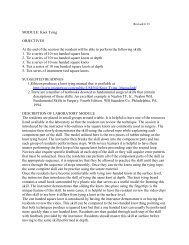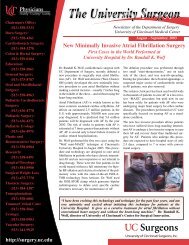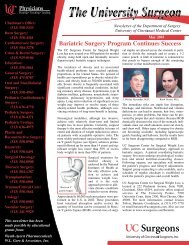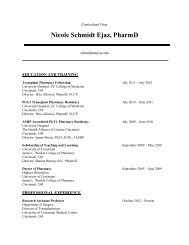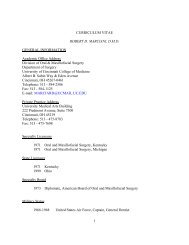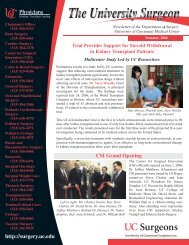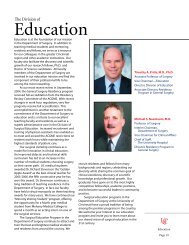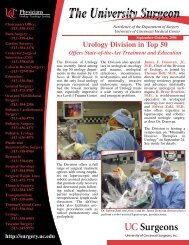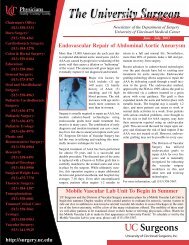UC Surgeon-Scientist Receives $1.5 Million Grant to Study Heart ...
UC Surgeon-Scientist Receives $1.5 Million Grant to Study Heart ...
UC Surgeon-Scientist Receives $1.5 Million Grant to Study Heart ...
You also want an ePaper? Increase the reach of your titles
YUMPU automatically turns print PDFs into web optimized ePapers that Google loves.
Winter 2005-2006<br />
<strong>UC</strong> <strong>Surgeon</strong>-<strong>Scientist</strong> <strong>Receives</strong> <strong>$1.5</strong> <strong>Million</strong><br />
<strong>Grant</strong> <strong>to</strong> <strong>Study</strong> <strong>Heart</strong> Enlargement/Failure<br />
<strong>Surgeon</strong>s at the University of Cincinnati<br />
College of Medicine have received <strong>$1.5</strong><br />
million <strong>to</strong> study the link between heart<br />
enlargement and heart failure. Shahab<br />
Akhter, M.D., Assistant Professor of<br />
Surgery in the Division of Cardiac Surgery,<br />
is principal investiga<strong>to</strong>r for the five-year<br />
study funded by the National Institutes of<br />
Health, National <strong>Heart</strong>, Lung and Blood<br />
Institute, and the Thoracic Surgery<br />
Foundation for Research & Education.<br />
Dr. Akhter believes that protein kinase C, a<br />
molecule that is activated when the heart<br />
becomes enlarged, “turns on” a specific<br />
enzyme that limits the heart’s ability <strong>to</strong><br />
respond <strong>to</strong> stress and pump efficiently. This<br />
can lead <strong>to</strong> poor heart function and, ultimately,<br />
heart failure.<br />
Dr. Akhter and his team will study the interaction<br />
between these signaling molecules<br />
in multiple lines of genetically engineered<br />
mice, each designed <strong>to</strong> express a specific<br />
kinase or kinase inhibi<strong>to</strong>r, in order <strong>to</strong><br />
identify new ways [see inside - “Akhter”]<br />
Dr. Shahab Akhter and Dr. Karyn Butler in their labs at the Cardiovascular Research Center.<br />
Trauma <strong>Surgeon</strong> Continues Innovative Cardiac Research<br />
Karyn Butler, M.D., F.A.C.S., F.C.C.M.,<br />
Associate Professor of Surgery, Division of<br />
Trauma and Critical Care, continues her<br />
research on hypertrophied hearts with support<br />
from a National Institutes of Health,<br />
Men<strong>to</strong>red Clinical <strong>Scientist</strong> (K08) Award.<br />
Cardiac chamber remodeling following<br />
myocardial infarction or in response <strong>to</strong><br />
hypertension may lead <strong>to</strong> left ventricular<br />
hypertrophy and cardiac failure. Preconditioning,<br />
or ischemic adaptation, repre-<br />
sents the intrinsic capacity of the heart <strong>to</strong><br />
protect itself from ischemic injury. The<br />
molecular basis of this phenomenon<br />
remains <strong>to</strong> be further characterized.<br />
Clinical and experimental studies indicate<br />
that hypertrophied hearts are more vulnerable<br />
<strong>to</strong> ischemic insult compared <strong>to</strong> nonhypertrophied<br />
hearts. In non-hypertrophied<br />
myocardium, cardiac preconditioning<br />
can attenuate ischemia/reperfusion<br />
induced contractile [see inside - “Butler”]
<strong>Surgeon</strong> Performs Region’s First Minimally Invasive<br />
Four-Arm Robotic-Assisted Gastric Bypass<br />
Calvin A. Selwyn, Jr., M.D., Assistant Professor of Surgery in<br />
the Division of Gastrointestinal and Endocrine Surgery, and<br />
Direc<strong>to</strong>r of Surgical Endoscopy and Laparoscopy, performed<br />
the Midwest's first minimally invasive gastric bypass procedure<br />
using a four-arm surgical robot on November 9, 2005. He is<br />
only the second surgeon in the world <strong>to</strong> do so. Dr. Selwyn’s<br />
technique allows self-assisted surgery that was once so complex<br />
that it required two surgeons <strong>to</strong> perform. He will be giving a<br />
presentation at the Pacific Rim Robotics Conference <strong>to</strong> be held<br />
in Anaheim, California in January 2006 <strong>to</strong> discuss this novel<br />
approach <strong>to</strong> bariatric surgery with some of the nation’s premiere<br />
robotic surgeons.<br />
Dr. Selwyn controls the four mechanical arms from an interactive<br />
console. Inserted in<strong>to</strong> the abdomen through several small<br />
tubes or “ports” without the need for a major incision, the arms<br />
function with the dexterity of human hands. The four-arm technology<br />
provides better depth perception and fine-motion control<br />
inside the abdomen than the three-arm approach, allowing the<br />
surgeon <strong>to</strong> operate with greater precision and control suturing<br />
techniques. “Robotic gastric bypass surgery minimizes complications<br />
common with open surgery, including hernias and pulmonary<br />
problems,” says Dr. Selwyn.<br />
“Akhter” (continued from front page)<br />
<strong>to</strong> prevent heart function deterioration. “If we can identify and<br />
block this molecular ‘cross-talk’ that contributes <strong>to</strong> heart failure,<br />
we can develop new, more precise therapies that reduce the incidence<br />
of disease and save more lives,” Dr. Akhter says.<br />
<strong>Heart</strong> disease is currently treated with a combination of drugs<br />
that reduce stress on the heart and improve blood flow. These<br />
include ACE (angiotensin-converting enzyme) inhibi<strong>to</strong>rs, which<br />
reduce blood pressure; beta-blockers, which block recep<strong>to</strong>rs <strong>to</strong><br />
slow the heartbeat and reduce muscle contractions; and diuretics,<br />
which help the body remove unneeded water and salt.<br />
“Beta-blockers and ACE inhibi<strong>to</strong>rs are effective in treating the<br />
symp<strong>to</strong>ms of heart failure, but clearly we need <strong>to</strong> do better. The<br />
average survival rate for someone with heart failure is just five<br />
years,” says Dr. Akhter.<br />
Dr. Calvin Selwyn at the controls of the daVinci robot system in the<br />
Surgical Simulation Labora<strong>to</strong>ry. (Pho<strong>to</strong> courtesy of Academic<br />
Health Center Public Relations/D. Davenport)<br />
Patients at the <strong>UC</strong> Center for Surgical Weight Loss undergo a<br />
rigorous presurgery evaluation that includes a review of dietary<br />
habits, exercise physiology, emotional counseling and physical<br />
examinations. Dr. Selwyn offers the robotic-assisted procedure<br />
<strong>to</strong> 30% of his patients. For more information, please call 513-<br />
475-7770.<br />
“Butler” (continued from front page)<br />
dysfunction. The preliminary data suggest that compensated<br />
hypertrophied hearts exhibit enhanced ischemic <strong>to</strong>lerance after<br />
preconditioning compared <strong>to</strong> non-hypertrophied hearts. This<br />
observation suggests that the signaling pathways involved in<br />
adaptive hypertrophy may enhance ischemic <strong>to</strong>lerance.<br />
Dr. Butler has also observed that this relative preservation of<br />
ischemic adaptation in the hypertrophied heart is lost in a timedependent<br />
manner as the heart transitions from compensated<br />
hypertrophy <strong>to</strong> cardiac failure. Her labora<strong>to</strong>ry explores this<br />
clinically relevant problem by studying the response of hypertrophied<br />
rodent hearts <strong>to</strong> changes in myocardial blood flow. The<br />
goal of this research is <strong>to</strong> identify strategies that may improve<br />
cardiac function in patients with underlying heart disease who<br />
experience angina or “heart attack.”<br />
“It is a pleasure men<strong>to</strong>ring two such brilliant scientists.”<br />
“The current state of art in pharmacotherapy of heart failure, considering its epidemic nature in the world, is very disappointing.<br />
Recent reviews have emphasized that we are dealing with a highly complex, multifaceted disease, yet the<br />
pipeline of new and exciting breakthrough drugs and/or therapy is at a trickle. Theoretically, one reason slowing the<br />
development of effective breakthrough pharmaceuticals is that we still lack thorough understanding of the intricate<br />
biology of the heart and vasculature. I am convinced that the research proposed by Drs. Akhter and Butler will uncover<br />
substantial information that will assist in the eventual completion of this complicated puzzle.”<br />
Arnold Schwartz, Ph.D.<br />
Direc<strong>to</strong>r, Institute of Molecular Pharmacology and Biophysics
<strong>UC</strong> Researcher <strong>Receives</strong> NIH <strong>Grant</strong><br />
Susan E. Waltz, Ph.D., Associate Professor of Surgery in<br />
the Trauma, Sepsis and Inflammation Research Group, has<br />
received a 5-year continuation grant from the Department<br />
of Health and Human Services, National Institutes of<br />
Health, National Institute of Diabetes and Digestive and<br />
Kidney Diseases, for her project “Hepa<strong>to</strong>cyte Growth<br />
Fac<strong>to</strong>r-like Protein Recep<strong>to</strong>r” which will be effective from<br />
September 2005 <strong>to</strong> June 2010.<br />
Susan Waltz, PhD (far right, front row) and her research group.<br />
Harvard Chief of Surgery <strong>to</strong> Visit <strong>UC</strong><br />
Andrew L. Warshaw, M.D., W. Gerald Austen Professor of<br />
Surgery at Harvard Medical School and <strong>Surgeon</strong>-in-Chief and<br />
Chairman of the Department of Surgery at Massachusetts General<br />
Hospital, will serve as the Ninth Annual Altemeier Visiting<br />
Professor, January 17-18, 2006.<br />
Andrew L. Warshaw, M.D.<br />
Dr. Warshaw is a leading authority on<br />
the pancreas and has made important<br />
contributions <strong>to</strong> the diagnosis and treatment<br />
of pancreatic cancer and the<br />
pathogenesis and management of pancreatitis.<br />
Dr. Warshaw serves as a governor of the<br />
American College of <strong>Surgeon</strong>s, and<br />
president-elect of the Halsted Society.<br />
He is past-president of the Society of<br />
Surgery of the Alimentary Tract and the<br />
International Association of Pancrea<strong>to</strong>logy.<br />
On Tuesday, January 17, 2006, Dr. Warshaw will discuss<br />
“Advocacy For and By <strong>Surgeon</strong>s” at the 4:00 p.m. Surgical<br />
Seminar, and will speak on “Management of Pancreatic Cancer” at<br />
Surgical Grand Rounds on Wednesday, January 18, 2006, in the<br />
Surgical Amphitheater.<br />
Pediatric Surgery Chief Recognized<br />
for International Service<br />
Richard Azizkhan, M.D., Direc<strong>to</strong>r of the Division of<br />
Pediatric Surgery, has been awarded the R.K. Gandhi Gold<br />
Medal, the highest award of the Indian Association of<br />
Paediatric <strong>Surgeon</strong>s (IAPS). The medal was presented at<br />
the 2005 IAPS Congress in Bangalore, India. Dr. Azizkhan<br />
was recognized for his work creating international medical<br />
exchange programs and for his contributions as a clinical<br />
scientist, particularly for his work with hemangiomas and<br />
vascular malformations and airway reconstruction.<br />
Dr. Richard Azizkhan (left) receives the R.K. Gandhi Gold Medal<br />
Dr. Azizkhan has trained pediatric surgeons in countries<br />
around the world, including India, and he has established<br />
formal relationships with universities and hospitals in<br />
countries in Europe, the Middle East and Asia. More than<br />
300 medical, surgical and nursing professionals have come<br />
for training at Cincinnati Children's from Bosnia, China,<br />
Croatia, Egypt, Finland, Germany, Italy, Japan, Jordan,<br />
Kuwait, Russia, Ukraine and other countries.<br />
Pediatric <strong>Surgeon</strong> in 3rd Marathon<br />
Brad Warner, M.D.,<br />
Professor of Surgery,<br />
Division of Pediatric<br />
Surgery, ran in the<br />
Columbus Marathon in<br />
Columbus, Ohio, on<br />
Oc<strong>to</strong>ber 16, 2005.<br />
Dr. Warner finished the<br />
marathon in 4 hours and<br />
18 minutes, a personal<br />
best time for him.<br />
This was Dr. Warner’s<br />
third marathon run.<br />
Dr. Brad Warner runs in the<br />
Columbus Marathon
Vascular Surgery Advances Minimally Invasive Care<br />
Joseph S. Giglia, M.D., interim direc<strong>to</strong>r of the Division of<br />
Vascular Surgery, performed the first minimally invasive<br />
endovascular surgery in the Tristate <strong>to</strong> repair a thoracic aortic<br />
aneurysm using the GORE TAG Thoracic Endoprosthesis, the<br />
only FDA-approved device of its kind. The procedure, which<br />
eliminates the need for a major chest incision, is a major<br />
advance for patients who are not viable candidates for traditional<br />
open surgery because of advanced vascular disease and<br />
other health complications. The 70-year-old patient underwent<br />
the procedure on Oc<strong>to</strong>ber 31 and was released from University<br />
Hospital a week later.<br />
Dr. Joseph Giglia holds an endovascular graft.<br />
(Pho<strong>to</strong> courtesy of Academic Health Center Public Relations/D. Collins)<br />
Many patients who suffer from thoracic aortic aneurysms also<br />
have serious health problems that make traditional open surgery<br />
<strong>to</strong>o risky. Endovascular repair is very promising because<br />
it gives those high-risk patients a better chance for survival.<br />
The procedure requires only a few small incisions in the groin<br />
where a catheter is inserted. Guided by live X-ray images and<br />
a video screen, Dr. Giglia locates the aneurysm and threads the<br />
catheter through blood vessels <strong>to</strong> the exact location. He then<br />
deploys the GORE TAG Thoracic Endoprosthesis stent-graft <strong>to</strong><br />
patch the interior of the diseased artery. The stent-graft is held<br />
in place against the vessel walls once it expands <strong>to</strong> full size.<br />
Once in place, the stent-graft supports the weakened vessel<br />
walls and allows blood <strong>to</strong> continue flowing through the aorta<br />
without applying pressure <strong>to</strong> the aneurysm. Without a blood<br />
supply, the aneurysm is less likely <strong>to</strong> rupture and will begin <strong>to</strong><br />
shrink over time.<br />
Repairing the diseased artery from inside the body minimizes<br />
the complications associated with open surgery and gives more<br />
patients an option for survival. The procedure also takes a quarter<br />
of the time required for open surgery and minimizes blood<br />
loss. Endovascular grafts allow repair of the aneurysm without<br />
a major chest incision, with less risk for infection, a shorter<br />
hospital stay, and faster recovery time.<br />
As seen in the pho<strong>to</strong> at left, <strong>UC</strong> vascular surgeons are using an<br />
outsourced image processing service (Medical Metrix<br />
Solutions) for thoracic aortic aneurysm patients that decreases<br />
procedures, devices, and cost. It provides critical information<br />
using data from the patient's routine CT studies, and obviates<br />
the need for invasive angiogram prior <strong>to</strong> endovascular<br />
aneurysm repair. “It is a very powerful <strong>to</strong>ol that allows precise<br />
preoperative planning and assists with intraoperative management,”<br />
says Dr. Giglia.<br />
As noted in the previous newsletter, Dr. Giglia also was the<br />
first in the Tristate <strong>to</strong> perform a minimally invasive, laparoscopic-assisted<br />
bypass procedure <strong>to</strong> treat aor<strong>to</strong>iliac arterial<br />
occlusive disease. Only a handful of centers are performing<br />
this procedure nationally. <strong>UC</strong> vascular surgeons plan <strong>to</strong> perform<br />
the operation completely with laparoscopic instruments<br />
in the near future and eventually with a surgical robot.<br />
Vascular Surgery Fellowship Direc<strong>to</strong>r<br />
<strong>Receives</strong> Honors and Funding<br />
Amy B. Reed, M.D., Assistant Professor of Surgery in the<br />
Division of Vascular Surgery, was appointed <strong>to</strong> the Ohio<br />
Chapter ACS (American College of <strong>Surgeon</strong>s) Women’s<br />
Committee and Ohio Chapter ACS Representative <strong>to</strong><br />
Association of Women <strong>Surgeon</strong>s. Dr. Reed was invited speaker<br />
at <strong>UC</strong>’s AMWA (American Medical Women’s Association)<br />
Chapter on being a woman in vascular surgery, as well as invited<br />
speaker at Ohio/Northern Kentucky/Indiana Society for<br />
Vascular Ultrasound on “Treatment and Management of<br />
Venous Disease in 21st Century.”<br />
On September 23, 2005, Mr. Greg Wallace of Bos<strong>to</strong>n Scientific<br />
presented the Vascular Surgery Fellowship Program with a gift<br />
for continuing education in vascular surgery.<br />
Dr. Amy Reed accepts gift from Greg Wallace of Bos<strong>to</strong>n Scientific
Making Strides Walk is Held <strong>to</strong><br />
Benefit American Cancer Society<br />
The Breast Cancer and Environment research group teamed up<br />
with Kathleen Heppner-Goss, Ph.D., and her team for the<br />
recent Making Strides Walk <strong>to</strong> benefit research sponsored by<br />
the American Cancer Society. Dr. Goss, Assistant Professor of<br />
Surgery in the Epithelial Pathobiology Research Group,<br />
receives funding from the ACS for research in breast cancer.<br />
Participants in Making Strides Walk for American Cancer Society.<br />
Plastic <strong>Surgeon</strong> is Invited Faculty<br />
at “Mini Medical College” Course<br />
Anureet Bajaj, M.D., Assistant Professor of Surgery, Division<br />
of Plastic, Reconstructive and Hand Surgery, was an invited<br />
speaker at the <strong>UC</strong> College of Medicine “Mini Medical College”<br />
on Oc<strong>to</strong>ber 25, 2005. Her <strong>to</strong>pic, “Extreme Makeover Edition,”<br />
provided guidelines and expectations for people considering<br />
plastic surgery, and detailed advanced microsurgical procedures<br />
for breast reconstruction. Dr. Bajaj is the only surgeon in the<br />
region <strong>to</strong> perform these microsurgical procedures.<br />
Dr. Anureet Bajaj speaks at Mini Medical College.<br />
(Pho<strong>to</strong> by Dan Davenport, provided by University of Cincinnati<br />
College of Medicine Development and Alumni Affairs.)<br />
Division of Urology Hosts Symposium<br />
for Prostate Disease Specialists<br />
The <strong>UC</strong> Division of Urology hosted a symposium for the<br />
Prostate Cancer Working Group on Tuesday, December 6,<br />
2005, at the Marriott Kingsgate Conference Center.<br />
Speakers included Drs. William Barrett, radiation oncology;<br />
Bruce Bracken, urology; Ralph Buncher, environmental<br />
health; James Donovan, urology; Shuk-mei Ho, environmental<br />
health; Karen Knudsen, cell biology; Ying Wai Lam,<br />
environmental health; Alex Lentsch, surgical research;<br />
Leslie Oleksowicz, hema<strong>to</strong>logy and oncology; Patricia<br />
Revelo, pathology; and Edward Silberstein, nuclear medicine.<br />
For information on the next meeting of the Prostate Cancer<br />
Working Group, please call 513-558-0983.<br />
Dr. James Donovan addresses the Prostate Cancer Working Group.<br />
Plastic Surgery Chief Visits Paris<br />
<strong>to</strong> Test Improved Facelift Results<br />
John Kitzmiller,<br />
M.D., Chief of the<br />
Division of Plastic,<br />
Reconstructive and<br />
Hand Surgery, was<br />
in Paris in August<br />
with a team from<br />
Ethicon Endo-<br />
Surgery <strong>to</strong> study<br />
applications of the<br />
Harmonic scalpel<br />
<strong>to</strong> reduce recovery<br />
after facelifts.<br />
Dr. John Kitzmiller (far right) with<br />
Australian plastic surgeon Dr. Andrew<br />
Greensmith and assisting nurse in Paris.
In Memoriam:<br />
Dr. Arthur Evans<br />
Arthur Evans, M.D., the former<br />
direc<strong>to</strong>r of urology at <strong>UC</strong> for over<br />
20 years from the 1960's <strong>to</strong> the<br />
early 1980's, passed away on<br />
November 9, 2005.<br />
Dr. Evans received his urology<br />
training at the University of<br />
Cincinnati. He advanced the clinical<br />
and educational programs in<br />
the Division of Urology and<br />
Dr. Arthur Evans trained many urology residents<br />
and fellows who went on <strong>to</strong> successful<br />
careers in academic and private practice, including Dr.<br />
Thomas Bell, a long-time member of the Division who has<br />
served as Chief of the Division as well as Direc<strong>to</strong>r of the<br />
Urology Residency Program.<br />
When Dr. Evans was promoted <strong>to</strong> the emeritus professor level<br />
by then chairman Dr. Josef Fischer, it was remarked that Dr.<br />
Evans was a visionary and ahead of the times, and an early<br />
developer of the concept that the pharmaceutical industry<br />
could assist in the promotion of continuing medical education.<br />
It was also said that “Art” (as he was called by all of his residents)<br />
lived <strong>to</strong> teach.<br />
All three sons of Dr. Evans are <strong>UC</strong> College of Medicine graduates.<br />
His daughter is a graduate of <strong>UC</strong>, and his grandson,<br />
Blake Evans, is a second year medical student at <strong>UC</strong>.<br />
Dr. Arthur Evans (middle row, third from right) as a resident during<br />
the chairmanship of Dr. B. Noland Carter (front row, center). Others<br />
include Dr. Bruce MacMillan (middle row, far left), Dr. John Wulsin<br />
(middle row, second from left), Dr. Robert (Bud) Coith (<strong>to</strong>p row, third<br />
from left), and Dr. William Culbertson (<strong>to</strong>p row, far right). Pho<strong>to</strong> is<br />
on the grounds of old General Hospital in 1950.<br />
Trauma <strong>Surgeon</strong>, <strong>UC</strong> Medical Student<br />
Travel <strong>to</strong> Africa on Healthcare Mission<br />
As part of a group of 14 <strong>UC</strong> faculty and students led by<br />
Dr. Chris<strong>to</strong>pher Lewis of <strong>UC</strong>’s Department of Family<br />
Medicine, Kenneth Davis, Jr., M.D., Professor of<br />
Surgery in the Division of Trauma and Critical Care, and<br />
medical student (and future surgeon) Callisia Clarke<br />
traveled more than 10,000 miles in late Oc<strong>to</strong>ber <strong>to</strong> the<br />
remote village of Shirati in northern Tanzania, Africa, <strong>to</strong><br />
provide much-needed healthcare. Dr. Davis, assisted by<br />
Ms. Clarke, performed several tumor and gallbladder<br />
removals in the regional hospital.<br />
Callisia Clarke and Dr. Ken Davis examine a patient.<br />
Dr. Ken Davis and Callisia Clarke perform surgery in Tanzania.<br />
Society of Black Academic <strong>Surgeon</strong>s<br />
<strong>to</strong> Visit Cincinnati<br />
The 16th Annual Scientific Session of the Society of<br />
Black Academic <strong>Surgeon</strong>s (SBAS) will be held April 6-8,<br />
2006, in Cincinnati, Ohio. Kenneth Davis Jr., M.D., is<br />
2006 SBAS Planning Committee Chair, and Karyn<br />
Butler, M.D., is Co-Chair.
Center for Surgical Innovation (CSI) in the News<br />
Surgery in Space Symposium<br />
Mr. Charles Doarn (Executive Direc<strong>to</strong>r) and Dr. Timothy Broderick<br />
(Medical Direc<strong>to</strong>r) of the CSI served as co-chairs along with Canadian<br />
Astronaut, Dr. Dave Williams, in conducting the inaugural Surgery in<br />
Space Symposium. The symposium, held adjacent <strong>to</strong> the NASA<br />
Johnson Space Center, was funded by Mr. Doarn's 2004 Dean's<br />
Discovery Fund and his $20,000 grant from the US Army's<br />
Telemedicine and Advanced Technology Research Center (TATRC).<br />
Industrial sponsorship was provided by MD Robotics. The day-and-ahalf<br />
symposium brought <strong>to</strong>gether a wide range of individuals, including<br />
astronauts, researchers and explorers who shared their experiences<br />
and challenges of performing surgery in space and during groundbased<br />
research. Future surgical systems, battlefield surgery, and the<br />
extremes of Mt. Everest were presented. CSI personnel at the symposium<br />
included Mr. Doarn, Dr. Broderick, Ms. Elyssa Westrich, Mr.<br />
Brett Harnett and surgery resident, Dr. Thomas Husted.<br />
Participants at the Surgery in Space Symposium<br />
Outreach<br />
CSI worked closely with Dr. Joseph Buell of the Division of<br />
Transplantation <strong>to</strong> develop a unique, information-rich web site on<br />
laparoscopic liver surgery. Entitled Lapliver.com, this site contains<br />
valuable information for patients and physicians alike. Visit the site at<br />
www.lapliver.com.<br />
Courses<br />
The CSI continues <strong>to</strong> work closely with several divisions within<br />
Surgery <strong>to</strong> develop training courses, which are sponsor-specific or<br />
CME. In September, CSI worked with Dr. Buell and Transplantation<br />
<strong>to</strong> hold the second “Advances in Laparoscopic Hepatic Surgery<br />
Course” which was attended by 30 surgeons from around the world.<br />
The CSI also worked with Au<strong>to</strong>Suture (US Surgical) <strong>to</strong> conduct an<br />
industry-sponsored lab, entitled “Laparoscopic Skills & Intracorporeal<br />
Suturing.” Both courses involved didactic and labora<strong>to</strong>ry sessions.<br />
CSI works closely with AtriCure through unrestricted education grants<br />
<strong>to</strong> conduct didactic training entitled “Closed Chest Seminars on the<br />
Minimaze.” Courses are coordinated here at <strong>UC</strong> and at the Cleveland<br />
Clinic. The <strong>UC</strong> courses held each month are attended by more than 20<br />
surgeons each time. These courses include a telesurgery component.<br />
<strong>Grant</strong>s<br />
CSI faculty received several grant awards in the past several months:<br />
* Dr. Broderick's second extension on his intergovernmental personnel<br />
agreement (IPA) with the US Army's TATRC.<br />
* Dr. Wolf began a clinical trial with AtriCure on Res<strong>to</strong>re-SR II,<br />
“Thoracoscopically-Assisted Epicardial Bilateral Pulmonary Vein<br />
Isolation Using the AtriCure Bipolar System and Exclusion of the Left<br />
Atrial Appendage for the Treatment of Atrial Fibrillation.” Dr. Wolf is<br />
the Principal Investiga<strong>to</strong>r (PI) of this multi-center trial.<br />
* <strong>UC</strong> has developed and signed a joint use agreement (JUA) with the<br />
Cleveland Clinic Foundation (CCF) in support of the CCF's WCI /<br />
BRTT award from the State of Ohio <strong>to</strong> develop the Atrial Fibrillation<br />
Innovation Center (AFIC). With final approval from the <strong>UC</strong> Board of<br />
Trustees and the State Controlling Board, this effort began on<br />
December 1, 2005. CSI has a significant role in this effort, including<br />
research focused on minimally invasive surgery. In addition, Dr. Wolf<br />
is on the Board of Direc<strong>to</strong>rs of the AFIC.<br />
* CardioEnergetics received an award notice that its proposal,<br />
“Evaluation of Durable Muscle-Prosthetic Bond for Artificial Tendons<br />
in Animate Models” was approved by NIH. <strong>UC</strong> and CSI will serve as<br />
the research partner. Mr. Doarn will serve as the PI for the <strong>UC</strong> side.<br />
CSI's role is <strong>to</strong> provide animal and surgery support.<br />
Capabilities<br />
CSI has worked closely with the Emergency Department (ED) <strong>to</strong><br />
develop linkages between the ED and the OR. This permits real-time<br />
videoconferencing between the ED and the OR. Cameras installed in<br />
the ED trauma bays provide an opportunity for teaching and collaboration<br />
as patients are transferred <strong>to</strong> surgery. This system provides a<br />
unique opportunity for ED <strong>to</strong> follow up on patients that it transfers for<br />
surgical intervention. This is a tremendous collaborative teaching <strong>to</strong>ol.<br />
CSI <strong>to</strong> Co-Sponsor “Nanoscience” Seminar<br />
The <strong>UC</strong> Department of<br />
Biomedical Engineering,<br />
the Institute for Nanoscale<br />
Science and Technology,<br />
and the CSI will sponsor a<br />
half-day free seminar on<br />
“Nanoscale Science and<br />
Technology in Medicine”<br />
on Friday, January 20,<br />
2006, from 7:30 am -<br />
12:30 pm at the Kingsgate<br />
Conference Center in<br />
Cincinnati. For information,<br />
visit the website at<br />
http://www.eng.uc.edu/<br />
dept_biomed/seminar_<br />
registration/page1.htm<br />
and click on the black but<strong>to</strong>ns<br />
at the <strong>to</strong>p <strong>to</strong> access<br />
speaker information, a<br />
schedule, and registration.
Christ Hospital Opens Pelvic Floor<br />
Center with Division of Colon and<br />
Rectal Surgery<br />
The Christ Hospital Pelvic Floor Center, a new highly specialized<br />
center aimed at treating pelvic floor dysfunction,<br />
brings <strong>to</strong>gether the expertise of urogynecologists and colon<br />
and rectal surgeons (Drs. Janice Rafferty, Bradley Davis,<br />
and David O'Brien) who work <strong>to</strong>gether <strong>to</strong> find the best and<br />
most appropriate treatment for pelvic floor problems. These<br />
specialists have expertise in diagnosis and treatment of disorders<br />
of the bladder, vagina, anus, and rectum.<br />
The Christ Hospital Pelvic Floor Center, the only such<br />
advanced center in a wide area, offers evaluation and treatment<br />
of fecal incontinence, debilitating constipation, pelvic<br />
organ prolapse causing bladder dysfunction, among others.<br />
This is the only center of its kind within a several-state<br />
radius. It offers unique evaluation and treatment capabilities<br />
<strong>to</strong> patients in Cincinnati and the surrounding region, including<br />
ultrasound evaluation of the anus and rectum, pelvic<br />
floor EMG, anal manometry, artificial bowel sphincter for<br />
those who need it, and pelvic floor reconstruction for fecal<br />
incontinence. Electromyography (EMG), the measurement<br />
of muscle activity, can be used <strong>to</strong> moni<strong>to</strong>r the pelvic floor<br />
muscles and provide visual and audible information <strong>to</strong><br />
patients as they learn <strong>to</strong> perform pelvic floor exercises<br />
(known as Kegels).<br />
Many people will experience problems with incontinence,<br />
bowel control, or pelvic pain. More often than not, individuals<br />
with these types of symp<strong>to</strong>ms are <strong>to</strong>o embarrassed <strong>to</strong> talk<br />
<strong>to</strong> their doc<strong>to</strong>r or seek help for many years before receiving<br />
any explanation for, or relief from, their disturbing symp<strong>to</strong>ms.<br />
These symp<strong>to</strong>ms could be directly related <strong>to</strong> what is<br />
called the pelvic floor.<br />
In the United States, millions of women and even men will<br />
experience some type of pelvic floor dysfunction. However,<br />
few women understand what is healthy and normal or immediately<br />
recognize signs and symp<strong>to</strong>ms that should be investigated<br />
further.<br />
For more information on the pelvic floor and symp<strong>to</strong>ms you<br />
may be experiencing, please call 513-585-4800 <strong>to</strong> speak with<br />
a specialist <strong>to</strong>day.<br />
Bradley Davis, M.D., was recently<br />
elected <strong>to</strong> the Hamil<strong>to</strong>n County<br />
American Cancer Society Advisory<br />
Board, and co-chairs the Colorectal<br />
Cancer Task Force Committee. He<br />
also is a member of the Speakers<br />
Bureau for the American Cancer<br />
Society, the Cincinnati Os<strong>to</strong>my<br />
Association (COA) and the Crohn’s<br />
Bradley Davis, MD Colitis Foundation (CCF). Dr. Davis<br />
has given lectures <strong>to</strong> the COA on “New<br />
Treatments for Colorectal Cancer” and <strong>to</strong> the CCF on<br />
“What's New in Inflamma<strong>to</strong>ry Bowel Disease.”<br />
<strong>Surgeon</strong> Sends Greetings from Iraq<br />
Robert Cavagnol, M.D., 2005 graduate of the general surgery<br />
residency training program, is currently serving in Fallujah,<br />
Iraq. Dr. Cavagnol recently received packages full of games,<br />
goodies, cigars, books, and more from the <strong>UC</strong> Department of<br />
Surgery, as well as a banner signed by numerous friends and<br />
colleagues. Dr. Cavagnol will return home in March <strong>to</strong> see his<br />
new family (wife Cindy is due Feb. 5th with their first boy).<br />
Dr. Rob Cavagnol in Fallujah with banner and packages.<br />
<strong>UC</strong> Pancreatic Disease Center <strong>to</strong> Hold<br />
Annual Symposium February 4, 2006<br />
The <strong>UC</strong> Pancreatic Disease Center will host the 5th Annual<br />
Symposium on Pancreatic Diseases February 4, 2006, at the<br />
Kingsgate Marriot Conference Center. Visit the website at<br />
www.ucpancreas.org for registration and more information.<br />
<strong>UC</strong> Surgery Alumni & Faculty Meet at ACS<br />
The Department of Surgery and the Mont Reid Surgical<br />
Society held its first annual joint dinner meeting at the 2005<br />
American College of <strong>Surgeon</strong>s (ACS) in San Francisco.<br />
(Left-right): Dr. Steve Albertson, Susie Fegelman, Dr. Elliott<br />
Fegelman, Dr. Edward Diekhoff, and Lisa Albertson at the ACS.
Dr. J. Wesley Alexander<br />
Dr. Anureet Bajaj<br />
Dr. Kathy Goss<br />
Awards and Achievements<br />
J. Wesley Alexander, M.D., Sc.D., Professor of Surgery in the Division of Transplantation, was<br />
awarded the second annual Distinguished Service Award by the Cincinnati Surgical Society on<br />
December 7, 2005.<br />
Anureet Bajaj, M.D., Assistant Professor of Surgery in the Division of Plastic, Reconstructive and<br />
Hand Surgery, passed the American Board of Plastic Surgery Oral Examination in November 2005.<br />
Kathleen Heppner Goss, Ph.D., Assistant Professor of Surgery in the Epithelial Pathobiology<br />
Research Group, was named as a YWCA of Greater Cincinnati Career Women of Achievement<br />
Rising Star at a luncheon on September 13, 2005.<br />
Wolfgang Stehr, M.D., surgery resident<br />
working in the labora<strong>to</strong>ry of Dr. Brad<br />
Warner, won the 3-minute oral presentation -<br />
Rosenkrantz Resident Research Award from<br />
the Surgical Section of the American<br />
Academy of Pediatrics in Washing<strong>to</strong>n, DC.<br />
His presentation, “STAT1 is an Inhibi<strong>to</strong>r of<br />
Adaptation after Massive Small Bowel<br />
Resection,” was accepted for publication.<br />
Brad W. Warner, M.D., Professor of<br />
Surgery, Division of Pediatric Surgery,<br />
served on the National Institutes of Health<br />
<strong>Study</strong> Section: NIDDK Special Emphasis<br />
Panel ZDK1 GRB-3(03) in August, 2005.<br />
Dr. Shahab Akhter Dr. Joshua Mammen Dr. Michael Nussbaum<br />
Dr. Shahab Akhter (Division of Cardiac Surgery) and Dr.<br />
Michael Nussbaum (Division of Gastrointestinal and Endocrine<br />
Surgery) were faculty inductees, and Dr. Joshua Mammen was<br />
resident inductee <strong>to</strong> Alpha Omega Alpha (AOA), the honorary<br />
medical society, at the AOA Annual Banquet on Friday, November<br />
18, 2005.<br />
Randall Wolf, M.D., and John B. Flege, Jr., M.D., Division of<br />
Cardiac Surgery, launched the new journal, INNOVATIONS:<br />
Technologies and Techniques in Cardiothoraic and Vascular<br />
Surgery (see right) on November 1, 2005. Dr. Wolf is co-edi<strong>to</strong>r and<br />
Dr. Flege is associate edi<strong>to</strong>r. The journal is the official publication<br />
of the International Society for Minimally Invasive Cardiothoracic<br />
Surgery (ISMIC), of which Dr. Wolf is President.<br />
(l-r) Wolfgang Stehr, MD, Nicole Bernal, MD, Kathryn<br />
Bernabe, MD, and Brad Warner, MD. The three are residents<br />
in Dr. Warner’s lab and had presentations at the American<br />
Academy of Pediatrics Surgical Section in Washing<strong>to</strong>n DC.
Recent Presentations<br />
Bernabe KQ, Bernal NP, Stehr W, Erwin CR, Warner BW: “Resection-induced intestinal adaptation and the role for enteric smooth muscle:<br />
cause or effect?” American Academy of Pediatrics - Surgical Section, Oc<strong>to</strong>ber 8-11, 2005, Washing<strong>to</strong>n, DC.<br />
Bernal NP, Stehr W, Zhang Y, Profitt S, Erwin CR, Warner BW: “Combined pharmacotherapy that increases proliferation and decreases apop<strong>to</strong>sis<br />
optimally enhances intestinal adaptation.” American Academy of Pediatrics - Surgical Section, Oc<strong>to</strong>ber 8-11, 2005, Washing<strong>to</strong>n, DC.<br />
Billmire DA: “Cleft nasal repair: Timing and techniques.” 2005 Tri-State Craniofacial Conference, Indianapolis, IN, Oc<strong>to</strong>ber 7, 2005.<br />
Doarn CR: “Surgical innovation - robotics.” Topics in Cardiovascular Care: New Concepts and New Technologies. Hillcrest Hospital,<br />
Cleveland, OH, Oc<strong>to</strong>ber 2005.<br />
Doarn CR: “Integration of technology for medical care.” US Air Force. Theater Trauma Medical Requirements: Translating Expeditionary<br />
Medical Needs for Development and Incorporation of New Technology. Cincinnati, OH, Oc<strong>to</strong>ber 2005.<br />
Doarn CR: “Telemedicine and remote surgery.” 2nd Dialogue on National Research and Education Networks in Latin America - “Health<br />
Through the National Research and Education Networks” - Internet 2 broadcast. VTC from Cincinnati <strong>to</strong> Argentina, Oc<strong>to</strong>ber 2005.<br />
Doarn CR: “Surgical innovation.” Dual Admissions Program Workshop. University of Cincinnati, Oc<strong>to</strong>ber 2005.<br />
Doarn CR: “Telemedicine and remote surgery.” Dia Virtual CUDI de Institu<strong>to</strong>s Nacionales de Salud - Internet 2 Broadcast. VTC from Cincinnati<br />
<strong>to</strong> Mexico, September 2005.<br />
Harnett BM: “Advanced network opportunities for surgical tele-robotics.” Imaging the Possibilities Conference, Bradley University, Peoria, IL,<br />
Oc<strong>to</strong>ber 2005.<br />
Harnett BM: “Advanced network opportunities for surgical tele-robotics.” Fall 2005 Internet 2 Member Meeting, Philadelphia, PA.<br />
Huber N, Ben-David K, Johannigman JA: “Abdominal compartment syndrome after damage control laparo<strong>to</strong>my with bowel left in closed loop<br />
discontinuity.” ACS Committee on Trauma Section V Resident Competition, Detroit Trauma Symposium, November 11, 2005.<br />
Huffman L: “Early results from lung cancer screening using spiral CT of high-risk individuals.” Chest 2005 meeting, Montreal.<br />
Parvadia J, Vaikunth S, Marwan A, Harkness U, Maldonado A, Alaee D, Kalinowska B, Stehr W, Uzvolgyi E, Erwin C, Warner B,<br />
Crombleholme T: “Role of vascular endothelial growth fac<strong>to</strong>r (VEGF) in small bowel adaptation after resection: EGF is VEGF dependent for<br />
the adaptive response.” American Academy of Pediatrics - Surgical Section, Washing<strong>to</strong>n, DC, Oc<strong>to</strong>ber 8-11, 2005.<br />
Pritts TA: “Endpoints of shock resuscitation.” Surgical Grand Rounds, Department of Surgery, Good Samaritan Hospital, Cincinnati, Ohio,<br />
November, 2005.<br />
Reed AB: “Management of abdominal aortic aneurysms.” Medicine Grand Rounds, University of Cincinnati, September 8, 2005.<br />
Reed AB: “Vascular surgery in 21st Century.” Invited Speaker, Halsted Society, Cincinnati, OH, September 9, 2005.<br />
Reed AB: “Timing of repair of blunt traumatic thoracic aortic transections.” Midwest Vascular Surgery Society Meeting, September 15, 2005.<br />
Reed MF: “Inhibition of retinoblas<strong>to</strong>ma tumor suppressor activity by RNA interference in lung cancer lines deregulates growth.” Southern<br />
Thoracic Surgical Association 52nd Annual Meeting, Orlando, FL.<br />
Stehr W, Bernal NP, Bernabe KQ, Erwin CR, Warner BW: “STAT1 is an inhibi<strong>to</strong>r of adaptation after massive small bowel resection.” American<br />
Academy of Pediatrics - Surgical Section, Washing<strong>to</strong>n, DC, Oc<strong>to</strong>ber 8-11, 2005.<br />
Warner BW: “Surgical options for management of ulcerative colitis;” “Necrotizing enterocolitis;” “Surgical options for management of gastroesophageal<br />
reflux;” “Surgical options for management of short bowel syndrome;” and “Resection-induced intestinal adaptation.” Aspen<br />
Conference on Pediatric Gastrointestinal Disease - Pediatric Gastrointestinal Disease and Intestinal Transplantation, July 17-22, 2005.<br />
Warner BW: “Update on Children's Hospital.” Halsted Society, September 9, 2005, Cincinnati, OH.<br />
Wolf RK: “Emerging technologies/robotics” and “Future of surgical training and the field of surgery.” American College of <strong>Surgeon</strong>s, San<br />
Francisco, CA, Oc<strong>to</strong>ber 17, 2005.<br />
Wolf RK: “Surgical treatment of atrial fibrillation.” American <strong>Heart</strong> Association, November 13, 2005.<br />
Wolf RK: “AF ablation, future of surgery-The Center of Surgical Innovation at <strong>UC</strong>-biosurgery in space;” “New surgical technique for the cure<br />
of AF;” “How <strong>to</strong> train young cardiothoracic surgeon in Asia;” and “Evolution of a minimally invasive cardiothoracic practice.” Annual Meeting<br />
of the JATS, Oc<strong>to</strong>ber 2005.<br />
Wolf RK: “Is pulmonary vein isolation alone appropriate therapy for patients with paroxymal AF?” and “What is new in off pump minimally<br />
invasive coronary artery surgery?” 4th EACTS/ESTS Joint Meeting, September 30-Oc<strong>to</strong>ber 2005.
Ahmad SA, Lowy AM, Wray CJ, D’Alessio D, Choe KA, James<br />
LE, Gelrud A, Matthews JB, Rilo HLR. Fac<strong>to</strong>rs associated with<br />
insulin and narcotic independence after islet au<strong>to</strong>transplantation<br />
in patients with severe chronic pancreatitis. J Am Coll Surg<br />
201:680–687, 2005.<br />
Bernal NP, Stehr W, Zhang Y, Profitt S, Erwin CR, Warner BW.<br />
Evidence for active Wnt signaling during postresection intestinal<br />
adaptation. J Pediatr Surg 40:1025-1029, 2005.<br />
Guo J, Sheng G, Warner BW. Epidermal growth fac<strong>to</strong>r-induced<br />
rapid retinoblas<strong>to</strong>ma phosphorylation at Ser780 and Ser795 is<br />
mediated by ERK1/2 in small intestine epithelial cells. J Biol<br />
Chem 280:35992-35998, 2005.<br />
Ignacio RC, Falcone RA Jr, Warner BW. Necrotizing fasciitis:<br />
a rare complication of neonatal necrotizing enterocolitis. J<br />
Pediatr Surg 40:1805-1807, 2005.<br />
Kim ES, Warner BW. Unexpected finding during inguinal hernia<br />
repair in a girl. Surgery 138:954-955, 2005.<br />
Merrell RC, Doarn CR. Disasters - how can telemedicine help?<br />
[Edi<strong>to</strong>rial] Telemed and E Health 11(5):511-512, 2005.<br />
Piasecki J, Lied A, Billmire D, Ludwig M, Bentz M. Congenital<br />
melanocytic nevus and the internet: an evaluation of available<br />
web-based resources. J Craniofacial Surgery 16:894-895, 2005.<br />
Prasad V, Boivin GP, Miller ML, Liu LH, Erwin CR, Warner<br />
BW, Shull GE. Haploinsufficiency of Atp2a2, encoding the<br />
sarco(endo)plasmic reticulum Ca2+-ATPase isoform 2 Ca2+<br />
<strong>UC</strong> Cancer Center’s first appendiceal cancer research benefit<br />
-- “A Night of Silence and Singing” -- generated more<br />
than $7,500 for local cancer research. Proceeds from the<br />
event go directly <strong>to</strong> the research efforts of Andrew Lowy,<br />
Recent Publications<br />
pump, predisposes mice <strong>to</strong> squamous cell tumors via a novel<br />
mode of cancer susceptibility. Cancer Res 65:8655-8661, 2005.<br />
Pritts SD, Fischer DR, Pritts TA. Managing morbid obesity:<br />
new options improve outcomes. J Fam Pract 54s:1-4, 2005.<br />
Pritts TA, Knight D, Davis BR, Porembka D, Cuschieri J.<br />
Accidental self-inflicted nail gun injury <strong>to</strong> the heart. Injury<br />
Extra 36:517-519, 2005.<br />
Pritts TA. Surgical simulation: time <strong>to</strong> practice how we play.<br />
RAS-ACS News, Summer 2005.<br />
Reed AB. Timing of repair of blunt traumatic thoracic aortic<br />
transections. J Vasc Surg, in press.<br />
Robb BW, Reed MF. Congenital diaphragmatic hernia presenting<br />
as splenic rupture in an adult. Ann Thorac Surg, in press.<br />
Speich JE, Cagle YD, Rafiq A, Merrell RC, Doarn CR,<br />
Broderick TJ. Evaluation of surgical skills in microgravity using<br />
force sensing. Medical Engineering & Physics 27:687-693,<br />
2005.<br />
Stehr W, Mercer TI, Bernal NP, Erwin CR, Warner BW.<br />
Opposing roles for p21(waf1/cip1) and p27(kip1) in enterocyte<br />
differentiation, proliferation, and migration. Surgery 138:187-<br />
194, 2005.<br />
Warner BW, Warner BB. Role of epidermal growth fac<strong>to</strong>r in the<br />
pathogenesis of neonatal necrotizing enterocolitis. Semin<br />
Pediatr Surg 14:175-180, 2005.<br />
“A Night of Silence and Singing” Raises Money for Cancer Research<br />
Cancer survivor Traci Wansack (center) and restaurant owners<br />
Vi<strong>to</strong> and Mary Ciepiel.<br />
M.D., direc<strong>to</strong>r of the Division of Surgical Oncology, and<br />
his team. More than 70 attendees were on hand for dinner<br />
and a silent auction at the event, held Saturday, Oct. 22,<br />
2005, at Vi<strong>to</strong>'s Café in Ft. Thomas, Kentucky.<br />
Dr. Andrew Lowy and wife Dr. Haydee Ojeda-Fournier with<br />
other participants at the benefit.
Surgical Grand Rounds Schedule<br />
January 11, 2006 Amod Sarnaik, M.D. (Chief Resident): “Controversies in Gastric Cancer”<br />
January 18, 2006 Altemeier Visiting Professor, Andrew L. Warshaw, M.D. (W. Gerald Austen Professor of<br />
Surgery, Harvard Medical School, and Chairman, Department of Surgery, Massachusetts<br />
General Hospital): “Surgical Management of Pancreatic Cancer”<br />
January 25, 2006 Shahab Akhter, M.D. (Cardiac Surgery): “On-Pump Versus Off-Pump Coronary Artery<br />
Bypass Surgery: Is There An Advantage <strong>to</strong> Avoiding Cardiopulmonary Bypass?”<br />
February 1, 2006 Colorectal Surgery<br />
February 8, 2006 Transplant Surgery<br />
February 15, 2006 Guest Speaker (Urology), Kevin T. McVary, M.D., Associate Professor of Surgery,<br />
Department of Urology, Northwestern University<br />
February 22, 2006 Kfir Ben-David, M.D. (Chief Resident)<br />
March 1, 2006 McDonough Visiting Professor, Ajit K. Sachdeva, M.D. (Direc<strong>to</strong>r, Division of Education,<br />
American College of <strong>Surgeon</strong>s)<br />
March 8, 2006 Russell Juno, M.D. (Chief Resident)<br />
March 15, 2006 Karyn Butler, M.D. (Trauma & Critical Care)<br />
March 22, 2006 Plastic Surgery<br />
March 29, 2006 Fischer Visiting Professor, Julie A. Freischlag, M.D. (William Stewart Halsted Professor<br />
and Chairman, Department of Surgery, Johns Hopkins University School of Medicine)<br />
The University <strong>Surgeon</strong> is published quarterly by <strong>UC</strong> <strong>Surgeon</strong>s, Inc.<br />
Written by Steve Wiesner, 558-4207, steve.wiesner@uc.edu<br />
Edited by Elizabeth Pierce, 558-1321, elizabeth.pierce@uc.edu<br />
Winter 2005-2006



